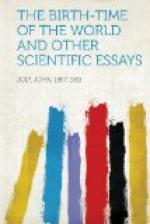It was a magnificent display of vitality; of the aggressiveness of vitality, assailing the barren heights of the limestone, wringing a subsistence from dead things. And the question suggested itself with new force: why the abundance of life and its unending activity?
In trying to answer this question, the present sketch originated.
I propose to refer for an answer to dynamic considerations. It is apparent that natural selection can only be concerned in a secondary way. Natural selection defines
[1] Proc. Roy. Dublin Soc., vol. vii., 1890.
[2] In the Dolomites of Southeast Tyrol; during the summer of 1890. Much of what follows was evolved in discussion with my fellow-traveller, Henry H. Dixon. Much of it is his.
60
a certain course of development for the organism; but very evidently some property of inherent progressiveness in the organism must be involved. The mineral is not affected by natural selection to enter on a course of continual variation and multiplication. The dynamic relations of the organism with the environment are evidently very different from those of inanimate nature.
GENERAL DYNAMIC CONDITIONS ATTENDING INANIMATE ACTIONS
It is necessary, in the first place, to refer briefly to the phenomena attending the transfer of energy within and into inanimate material systems. It is not assumed here that these phenomena are restricted in their sphere of action to inanimate nature. It is, in fact, very certain that they are not; but while they confer on dead nature its own dynamic tendencies, it will appear that their effects are by various means evaded in living nature. We, therefore, treat of them as characteristic of inanimate actions. We accept as fundamental to all the considerations which follow the truth of the principle of the Conservation of Energy.[1]
[1] “The principle of the Conservation of Energy has acquired so much scientific weight during the last twenty years that no physiologist would feel any confidence in an experiment which showed a considerable difference between the work done by the animal and the balance of the account of Energy received and spent.”—Clerk Maxwell, Nature, vol. xix., p. 142. See also Helmholtz On the Conservation of Force.
61
Whatever speculations may be made as to the course of events very distant from us in space, it appears certain that dissipation of energy is at present actively progressing throughout our sphere of observation in inanimate nature. It follows, in fact, from the second law of thermodynamics, that whenever work is derived from heat, a certain quantity of heat falls in potential without doing work or, in short, is dissipated. On the other hand, work may be entirely converted into heat. The result is the heat-tendency of the universe. Heat, being an undirected form of energy, seeks, as it were, its own level, so that the result of this heat-tendency is continual approach to uniformity of potential.




